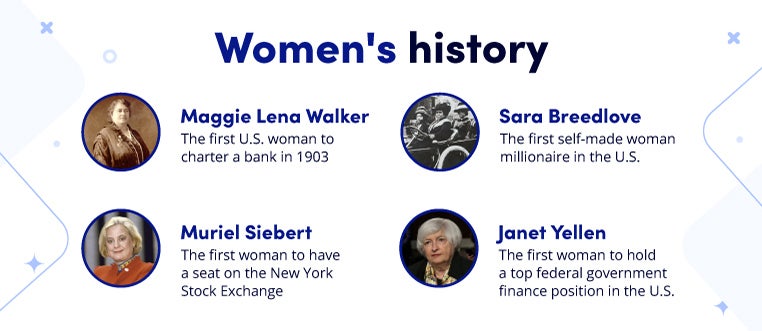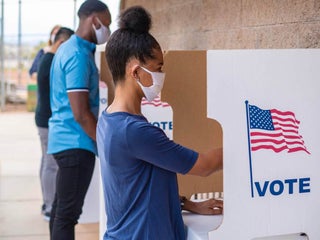Summary
From the #MeToo movement to the push for more affordable child care to the droves of women running for office (and winning elections), there is so much women can and are doing to change the world, for themselves and their daughters.
The content on this page is accurate as of the posting date; however, some of our partner offers may have expired. Please review our list of best credit cards, or use our CardMatch™ tool to find cards matched to your needs.
The pandemic has certainly been one for the books. Over-represented in the service sector, women were laid off in droves when it shuttered restaurants, gyms and shops. And Black, Latina and Asian women got hit the hardest with unemployment.
Others stopped working because, without the support of child or elder care, they couldn’t earn an income and tend to others. In 2021, women’s workforce participation was down to 57%, the lowest in three decades. Meanwhile, reports of abuse went up – one radiology study of patients at a Boston hospital found injuries consistent with domestic abuse in 26 patients between March 11 and May 3, 2020 – in contrast, there were 20 such patients in 2019, and seven in 2018, over the same seven-week period.
But there are also so many reasons to hope. From the #MeToo movement to the push for more affordable child care to the droves of women running for office (and winning elections), there is so much women can and are doing to change the world, for themselves and their daughters.
See related: What is Equal Pay Day?
Why we need Women’s History Month
In the face of ongoing struggles, the need to celebrate Women’s History Month, as the United States does each March, is pressingly obvious. Women’s History Month reminds us of what women have achieved in the face of numerous and towering obstacles, and by doing so, encourages us to continue to strive for a more equitable world.
“We need Women’s History Month to focus on the many ways women suffer gender injustice: unequal pay, sexual harassment, sexual assault, domestic violence, trafficking, lack of child care, invisibility, indifference and the attempt to control their reproductive choices,” said Ruth Rosen, professor emerita of history at the University of California, Davis. “Having a month that pays attention to women’s lives – both their great accomplishments and the ways they are subordinated – makes it hard for society to ignore women’s lives in general.”
Before it was a month, it was a week. Before it was a week, it was a day. The first recorded Woman’s Day was in 1908, when 15,000 women marched down the streets of New York City, demanding shorter work hours, higher wages and the right to vote. By 1913, on the eve of World War I, with many women around the world campaigning for peace, the date for International Women’s Day was set to March 8 – which remains the date today. It was celebrated by the United Nations for the first time in 1975.
Three years later, in 1978, a county women’s commission in Santa Rosa, California, decided to announce a Women’s History Week, pegged to International Women’s Day. In 1980, a group of women’s organizations and historians lobbied for national recognition, and President Jimmy Carter complied, declaring the week of March 8, 1980, as the first National Women’s History Week. Seven years later, Congress passed a law declaring March to be Women’s History Month, and it’s been celebrated in March ever since.
The long fight for women’s financial well-being
Women’s participation in the workforce has varied widely by era and by circumstances. As Harvard economist Claudia Goldin has shown, women in pre-industrial America actually had a high participation in the workforce, which began to drop precipitously in the nineteenth century as the nation’s economy moved away from agriculture and towards manufacturing.
Female workforce participation hit a nadir in the late nineteenth century, then proceeded to do a steady climb upwards. In 1950, according to the federal Bureau of Labor Statistics, women accounted for about one-third of the total labor force. By 2015, women comprised nearly half, or 46.8%, of the overall labor force.
But many women never had the luxury of staying out of the workforce. Black women in particular worked throughout the pre-industrial and industrial era; much of the leisure white women enjoyed depended on the labor of their Black counterparts.
Often, this was because Black men didn’t earn enough alone to support a family. Black women’s need to work “was an economic enforcement as well as a societal enforcement,” said Janus Adams, an Emmy-award-winning journalist and the author of “Sister Days; 365 Inspired Moments in African American Women’s History.” “The economic enforcement was the paltry wages that Black people were paid. Even Black men. It was very, very rare that a Black man was in a position to not have a paltry wage,” Adams said.
Women today continue to fight for workplace and financial equity. They must battle sexism in hiring, pay inequity on the job and at all times, an expectation that they will spend discretionary income on their appearance to a degree that would be considered absurd – even vain – for many men.
Historical women in finance and their impact
These five women impacted finance in major ways:
- Maggie Lena Walker: Walker was the first U.S. woman to charter a bank in 1903. The bank was called St. Luke’s Penny Savings Bank, and she was president of it until she died in 1934. Walker championed women and African American women in particular, and her bank helped them save their money. The bank, which survived the 1929 Wall Street Crash, merged with two other banks and still operates today in Virginia.
- Sara Breedlove: Sara Breedlove, a Black entrepreneur born in 1867 to enslaved parents, invented a haircare line for African American women that made her a millionaire. She and her husband founded the Madame C.J. Walker Company, and the rest is history.
- Louise M. Weiser: When Weiser’s husband, Horace Weiser, died in 1975, she took over as president of Winneshiek County Bank in Decorah, Iowa, making her the first woman president of an American bank. Her son took over as president in 1892 and Weiser died in 1898.
- Muriel Siebert: In 1967, Siebert became the first woman to have a seat on the New York Stock Exchange, and she shared the floor with 1,365 males. In 1977, she formed her own brokerage firm and also served as superintendent of banking in the state of New York.
- Janet Yellen: When Yellen became U.S. treasury secretary for the Biden administration on Jan. 26, 2022, she also became the first woman to hold a top federal government finance position. In addition, she served as the chair of the Board of Governors for the U.S. Federal Reserve from 2014 to 2018, which made her the first woman to hold that position.
How to celebrate Women’s History Month every day
The point of having a Women’s History Month isn’t to only focus on women for 31 days of the year – it’s to spark an interest in doing more the other 334 days as well.
Pay attention to the news, particularly on issues you care about, advises Kate Nielson, the senior director of public policy research and legal advocacy for the American Association of University Women (AAUW), a Washington, D.C.-based non-profit. Connect with organizations you care about, who can help point you to relevant news and give you specific tips on what to do to affect change. The AAUW, for example, closely tracks gender equality issues and will send out action alerts to its members, she said.
Finally, and most importantly, reach out to your elected officials, at the local, state and federal levels, and tell them what you care about and what you’d like them to do about it. “Make sure you’re their boss,” Nielson said. “Make your own history, and make sure they are listening to you and representing your positions.”
How we can go further
Talk about finances with your daughter early
“A general financial awareness is critical for all kids,” Nielson said. “But it’s important to make sure girls in particular feel empowered with how they save and spend their money.”
A study found that parents were likely to talk about personal finance with both boys and girls. But boys were more likely to learn about credit scores, credit cards, opening a bank account, paying taxes and investing. Girls were more likely to be taught about budgeting, saving and tracking their spending, according to the report from Giftcards.com.
But you could argue that what girls really need to learn is how to make money. Women are more likely to be impoverished than men, less likely to work and less likely to have a bank account. So, consider making your daughters, as well as your sons, authorized users on your credit card. Talk to all your kids about financial literacy. “We should ensure we’re not talking drastically different to our daughters and sons,” Nielson said.
Know that your vote counts
Women only got the right to vote in 1920, after more than a half-century of fighting for it. Many men at the time resisted, believing harm could come of it. “It would mean a degeneration and a degradation of human fiber which would turn back the hands of time a thousand years,” William Sedgwick, a professor at the Massachusetts Institute of Technology, said in 1914. “Hence it will probably never come, for mankind will not lightly abandon at the call of a few fanatics the hard-earned achievements of the ages.”
It would be another 45 years before the Voting Rights Act of 1965 effectively extended voting rights to American women of all races.
Since 1984, women have voted at a higher rate than men. And they vote differently. They tend to vote more for Democrats, according to a 2020 Pew Research poll. They are more likely to prefer an active role for government in social programs, and less likely to vote for military interventions. Commit to being an engaged citizen: Make sure you are registered to vote, and when the time comes, make a plan to do so, whether that’s voting by mail, or knowing where to go in person to cast your ballot.
Stand up for women’s issues
One place to start is the ERA, the Equal Rights Amendment. The ERA is a child of the 1970s, an amendment to the Constitution that fell just shy of the two-thirds of states needed to ratify it and make it the law of the land.
However, in recent years, a few more statehouses have stepped up to ratify the ERA. It’s now reached the necessary limit, but it needs to be recognized as ratified by the House and the Senate. The House has done so. The Senate has not taken the issue up and it’s not clear the votes are there to do so. Plus, there’s also the question of whether the previous ratifications expired after decades had passed. If this matters to you, let your Senator know.
Wondering what’s in this controversial amendment? Here’s the text:
Section 1: Equality of rights under the law shall not be denied or abridged by the United States or by any state on account of sex.
Section 2: The Congress shall have the power to enforce, by appropriate legislation, the provisions of this article.
Section 3: This amendment shall take effect two years after the date of ratification.
Find where to donate
If you’re interested in donating to women’s causes, whether it’s for women’s education, health, social services or rights, make sure you find a trusted charity. Here are a few examples of organizations fighting to advance women’s rights and related issues:
- NOW (the National Organization for Women)
- Child Care Aware of America
- Equal Pay Today
- American Association of University Women
- Run For Something
Before you donate cash, check your issuer’s loyalty program’s charity page and see if it includes the charity to which you want to give: You might be able to donate cash back, miles or points. Four major issuers enable customers to donate this way: American Express, Discover, Chase and Citi. This is a great way to give if you’re short on cash but still want to help.
And remember: March is only one month out of 12. There’s much to do the rest of the year, and the effort starts with you. “On the most basic level, be curious about what’s going on, about women and girls are being treated,” Nielson said. “History unfolds every day.”
Editorial Disclaimer
The editorial content on this page is based solely on the objective assessment of our writers and is not driven by advertising dollars. It has not been provided or commissioned by the credit card issuers. However, we may receive compensation when you click on links to products from our partners.





